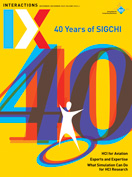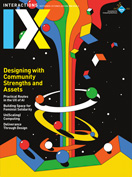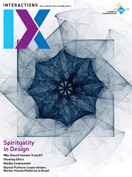Authors:
Alejandra Gonzalez, Jessa Dickinson, Aakriti Chugh, Travis Rejman, Burrell Poe, Sheena Erete
As designers and researchers in HCI, it's our nature to solve problems. We work hard to spot pain points and user frustrations, and we develop the skills to fix deficiencies within our software, our devices, and even within the smallest interactions of our everyday lives. When we broaden our design scope from individuals interacting with technologies to communities interacting with sociotechnical systems and apply the same approach of "uncovering" problems, we tend to take a deficit approach. Using this approach, we seek to uncover "needs," thereby positioning designers as "fixers" rather than facilitators of a collaborative process that centers the communities' expertise, lived experiences, strengths, capacities, and assets [1]. Given that a deficit approach is embedded in research and design methodologies and mentalities, we ask: How can we support designers in shifting from a deficit approach to one that collaboratively and intentionally leverages a community's assets to further their self-defined goals? Furthermore, what should the role of the designer be in an assets-based community development [2] process and how can we shift the power and process to allow those who are not formally trained as designers to reimagine what it means to lead the design of systems and practices in their communities?
This question emerged throughout our work with a team of assets-based community development (ABCD) [3] experts and community leaders in Chicago. Working as a collaborative group of academic researchers and community organizers, our academic team partnered with the Goldin Institute, a Chicago-based nonprofit organization that supports community grassroots leaders from across the globe to organize community action using an assets-based approach. These leaders are part of the Goldin Institute's Peace Fellows program, which provides educational resources and support through an established community of assets-based practices to further their existing community work. Taking an assets-based approach is central to the Peace Fellows program; however, few digital tools exist to scaffold the process. For this reason, the Goldin Institute leaders approached our team to collaboratively design and build an interactive, digital tool that the fellows could use during their process of building an asset map (i.e., a shared document of community-defined and -identified resources, strengths, and capacities that can vary in form) of their neighborhood.
→ Designers that support community-led approaches to asset mapping should focus on the process (e.g., building trust and community relationships).
→ As designers, it's our responsibility to consider the role of power in our work and decenter ourselves in the process by designing ourselves out of new tools and methods.
Our partnership began during the inaugural cohort of Chicago Peace Fellows, which gave us the opportunity to interview and learn from the Peace Fellows about the ways in which some of them were already developing asset maps. We interviewed over 25 professionals who are experts in assets-based community development, many of whom are a part of and lead community-based organizations. Each person we spoke with had previous experience with creating an asset map—some took a digital-mapping approach, while others preferred to hand-draw their neighborhoods. The fellows made it clear that identifying assets on a map wasn't the challenge we thought it was. Rather, they were looking for ways to communicate with their organizations and members of their communities about why they should develop a map in the first place. They wanted tools that could support community conversations and get input from other voices, not simply a new digital tool to collect data and/or develop a map. We used this finding as the bedrock for our design, reconsidering what an asset-mapping tool could look like. Additionally, after hearing about constraints on access to technology faced by Peace Fellows and Chicago grassroots leaders and their communities, we pivoted from our original goal of designing a digital tool to instead designing an analog toolkit to scaffold conversations for uncovering assets and understanding the asset-mapping process. What we took away from our initial interviews, literature reviews, and early analysis is that asset mapping is an ongoing, collaborative process that relies on trust to support relationship-building and is driven by conversation. We also learned that organizations engaging with asset mapping don't always rely on a map or technology to begin their process, which helped us forge an alternative path from creating a digital tool. Throughout our process, we met with Peace Fellows multiple times to gather input on our prototypes, working the feedback we received into new iterations. From this work, we codesigned an assets-mapping toolkit consisting of five tools. The purpose of each tool is to help community leaders facilitate conversations around identifying assets, inviting insights from neighbors, setting goals and intentions for creating an asset map, as well as developing a shared and common language among organizations and their communities.
We struggled through our process of designing the asset-mapping toolkit. Not only did we wrestle with the decision to move away from our original goal of creating a digital product, but we also reflected critically on the power we held as designers and academic researchers in this process. During our conversations with the Peace Fellows, we learned that many of our participants had prior experience engaging in academic research, though their experiences were not always positive. As a team of academics and community partners, we understood that our experiences examining the role of power in HCI [4] requires that we address power in our design outcomes. In order for us to hold ourselves accountable, we considered what our roles in the toolkit would look like long-term and questioned how we could design a tool that challenged power dynamics where there is a formally trained designer facilitating the design process. The community leaders who brought the issues of institutional power to the forefront of our conversations helped us realize that we would need to better understand our own capabilities as a team of designers with limited time and resources, and find a way to decenter ourselves from the process. In other words, in order for our design engagement to be successful, the toolkit should not require a formally trained designer to facilitate its use. Instead, we designed the toolkit such that it is owned by the communities who use it, where community members could confidently lead effective community conversations about local assets without assistance.
Another finding that was critical to our work was that in Chicago (where this work took place), as well as the rest of the U.S. and across the world, inequities in access to the Internet and technology remain high. Our community partners reminded us that just a few miles from where our institution sits—where our school is filled with access to computers, technology, the Internet, and classes—Chicago residents navigate their daily lives with limited access to the Web and technological devices; therefore, our design should not be exclusively based on technology access.
These two findings informed our decision to "design ourselves out," meaning that the toolkit was designed to be used without our facilitation or guidance. This was an important step in our design process, as we considered the harm and negative impacts we could potentially cause if we were the ones to facilitate the toolkit's use (e.g., after our eventual exit, whether in three years or 20 years).
The kit includes:
- An onboarding booklet that explains the tools and asset-mapping process as well as provides support on working with community data, such as prompts to think through who owns the data and how it will be shared, distributed, and stored
- A road map of instructions to print and create a map, along with questions to consider when identifying assets
- A deck of conversation cards that steer community conversions through the process of both identifying and activating assets
- A language exercise that lets groups of people come together over defining a key term (e.g., the word asset)
- A list of data resources available to communities in Chicago (where this research was based).
Onboarding Booklet. To use the toolkit, a community organization or group begins with the Onboarding Booklet (Figure 1). In speaking with the Peace Fellows, we learned that a challenge with community asset mapping is having enough information to get started. We tried to address this by providing this booklet as a guide that orients the toolkit's users and provide support along the way. The booklet includes steps for getting started, background information on ABCD, a group of writing prompts to define goals, definitions to help people understand common terms, and tips for collaborative work. The booklet is designed not only to help folks integrate with the toolkit, but to also be a resource for whenever further help is needed.
 |
Figure 1. Onboarding Booklet. |
Road Map. In the early stages of our work, we quickly learned that not all organizations will create their map in the same way and no single process could address the needs of organizations with different sizes, goals, and communities. Rather than develop a one-size-fits-all approach to using the toolkit, the Road Map (Figure 2) offers a suggested path for working through the tools while providing additional considerations for an organization to think about. Here, one can also find ideas for obtaining a large map of the community's area (e.g., hand-drawn, printed, online maps). We note that while a map is not necessary or required to move through each of the tools, it can be helpful to visualize the space in which assets will be mapped in the future. The Road Map asks participants to consider details when identifying assets, such as: Who owns this asset? How is it used by the community? Who has access to this asset?
 |
Figure 2. The Road Map. |
Community Conversation Cards. If a community group only uses one tool in the whole kit, we'd recommend the Conversation Cards (Figure 3). Throughout our research, we heard from different organizational leaders that there was a need for a tool to help communicate the goals and process of asset mapping with their communities, which we tried to address through this deck of cards. Designed to help shape meaningful conversations that build over time, the Conversation Cards lead communities and organizations through a range of topics, from ice breakers, to identifying community resources, to developing strategies for activating assets.
 |
Figure 3. Community Conversation Cards. |
We developed this idea after hearing from one community leader who used a candy jar and handwritten questions to help lead discussions. The candy jar held small pieces of paper with a question written down on each one and was used to kick off each meeting in small group settings. The questions asked things like "Do you use social media?" and were created to get to know everyone before diving into the meeting's agenda. Our team was inspired by this idea and focused on putting community-defined assets at the center of the conversation.
Key Terms. The Key Terms exercise (Figure 4) is designed to help members of an organization develop a shared understanding of words and concepts that may be important to the asset-mapping process. In this activity, we've offered a term (e.g., community wealth) and a definition, with space and instructions for participants to rewrite the definition in their own words. Once different members of the same organization work through the exercise, they can share their definitions and understandings. It's our hope that this tool supports collaboration among community members by helping them overcome barriers related to varying language that may be used in community-building conversations, including conversations around community-owned data practices. During our interviews, Peace Fellows suggested terms such as community resources, assets, and community leader to explore through this exercise.
 |
Figure 4. Key Terms exercise. |
Resource List. Finally, the last tool in the kit (Figure 5) is designed to better support communities based in Chicago (the city in which our research took place); however, we hope it will inspire community organizations in other locations to think about ways in which they can use publicly available data to support their goals. As an academic research team, we were made aware of the importance of public data early in our academic careers, and as designers who focus on equity, we wanted to share this knowledge and explain how it could be used by communities whose residents share common goals.
 |
Figure 5. Resource List. |
Around the time we developed a working prototype to test with the Peace Fellows, we received news that Chicago would be going into lockdown as a safety measure against the Covid-19 pandemic. As a result, we were unable to test the toolkit in-person, as we originally planned; however, we evaluated its use with community leaders over several virtual sessions and learned that providing language and tools around the process of asset mapping was helpful for community organizations in the early stages of their work. We also received feedback that in order for the toolkit to be successful, we'd need to develop a way to support organizations who engage with the toolkit over an extended period of time. Based on this feedback, we've created a website where we can share these tools more broadly with the public (https://tsg.cdm.depaul.edu/asset-mapping-project/). We hope to create a repository in the future, where teams of academic researchers and community-based organizations can design and share their asset-mapping tools, processes, and takeaways with others. We learned that the process of engaging in asset-mapping is as critical as the data collected. There are several ways of creating an asset map that are just as valuable as the map itself, and we hope to someday uncover new ways to share this experiential knowledge.
This toolkit wouldn't have been possible without the support and dedication of Howard Rosing and funding from the Steans Center for Community-Based Service Learning & Community Service Studies. We also thank the ABCD Institute, Oz Ozburn, Sydney Simon, Jesse Stellewagon, Naveen Siddiqui, Karen Wang, and Paola Favela.
1. Kretzmann, J. and McKnight, J. Building Communities from the Inside Out: A Path Toward Finding and Mobilizing a Community's Assets. The Asset-Based Community Development Institute, 1993.
2. Mcknight, J. and Kretzmann, J. Mapping community capacity. In Community Organizing and Community Building for Health and Welfare. M. Minkler, ed. Rutgers Univ. Press, 2012; 171–186; https://doi.org/10.36019/9780813553146-012
3. Asset-Based Community Development Institute; https://resources.depaul.edu/abcd-institute/Pages/default.aspx
4. Erete, S., Rankin, Y., and Thomas, J. A method to the madness: Applying an intersectional analysis of structural oppression and power in HCI and design. Transactions on Computer Human Interactions. ACM, New York, in press.
Alejandra Gonzalez is a designer research assistant at DePaul University in Chicago. She is interested in understanding the relationships between power and design and approaches research from a community-centered and justice-oriented lens. [email protected]
Jessa Dickinson is a Ph.D. candidate in the human-centered design program at DePaul University in Chicago. She facilitates codesign projects with community partners to create systems that address the community's priorities, with a focus on how power structures affect the issue the community is designing for, the research collaboration, and the project's sustainability. [email protected]
Aakriti Chugh is a UX designer and a graduate of DePaul University's HCI program. She finds her purpose in understanding and representing human needs, from ensuring that participants are protected by ethical research practices to prioritizing the end user's experience in design decisions. [email protected]
Travis Rejman is the executive director of the Goldin Institute, a global nonprofit based in Chicago that has inspired, equipped, and connected grassroots leaders in more than 60 countries over the past 19 years. Most recently, he has been focused on refining the GATHER platform to support communities of practice as they learn and work together to tackle tough issues across boundaries. [email protected]
Burrell Poe is the director of the Chicago Peace Fellows. Burrell is a U.S. Army veteran from the West Side of Chicago with a passion for supporting grassroots leaders and building community. [email protected]
Sheena Erete is an associate professor in the School of Information at the University of Maryland College Park. Her work focuses on codesigning sustainable technologies, practices, and policies with community organizations to counter structural oppression using equity-centered, justice-oriented, assets-based approaches to research and design. [email protected]
Copyright held by authors. Publication rights licensed to ACM.
The Digital Library is published by the Association for Computing Machinery. Copyright © 2022 ACM, Inc.











Post Comment
No Comments Found